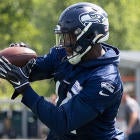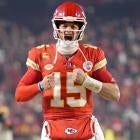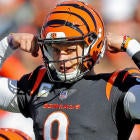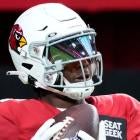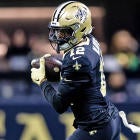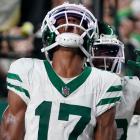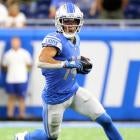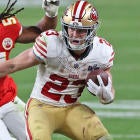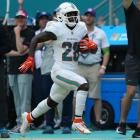Welcome to our 2019 Player Profiles series. We are going through the top-150 in Heath Cummings, Jamey Eisenberg and Dave Richard's consensus PPR rankings to give you the case for and the case against drafting each player. By the time you're done, you'll know everything you need to know for drafting in 2019.
Here are players 130-121, beginning with sleepers at wide receiver and running back:
130. Kalen Ballage, RB, MIA
The Case For: A fourth-round pick last year, Ballage impressed in limited time as a rookie, most notably ripping off a 75-yard touchdown run in Week 15. With Frank Gore gone, plenty of touches are available in the Miami backfield, and Ballage looks to have the inside track on one of the top two spots on the depth chart.
The Case Against: It's not great practice to remove the best run from a player's sample, but it's notable that outside of his long touchdown, Ballage's other 35 carries went for 3.3 yards per. He also only saw 11 targets and appears to be, at best, looking at a timeshare with established pass-catcher Kenyan Drake. Miami also added depth at the position this offseason, drafting four-year producer Miles Gaskin out of the University of Washington and signing 2018 fourth-round Bengals castoff Mark Walton and AAF standout Kenneth Farrow. Even if Ballage earns a strong workload, the Dolphins' offense might cap his ceiling.
129. Michael Gallup, WR, DAL
The Case For: Gallup caught fewer than 50% of his targets last season, but a whopping 26 of his 68 targets were uncatchable, per Sports Info Solutions. The former Colorado State star still posted a decent 7.5 yards per target in his rookie season thanks to 15.4 yards per reception and just one drop. The addition of Randall Cobb and return of Jason Witten shouldn't impact Gallup's downfield targets much, and he looks locked into the second outside receiver spot opposite Amari Cooper, who should draw more coverage.
The Case Against: The Cowboys don't throw a ton, and Gallup's profile looks dangerously close to Terrance Williams' before him. He has the potential to be a plus version of that, but as long as Amari is on the other side and there are several underneath targets in the offense, Gallup will likely post both boom and bust weeks, with a volume ceiling limiting his overall production. He's more appealing in best ball formats than weekly leagues.
128. Russell Wilson, QB, SEA
The Case For: Seattle ran on 52.8% of its total plays, a likely unsustainable rate given it was more than three percentage points higher than any other team in the past three seasons. Wilson still displayed his trademark efficiency, posting a career-high 8.2% touchdown rate and averaging over eight yards per attempt for the third time in his career. He could also be in for a bit of positive regression on the ground given he failed to score a rushing touchdown for the first time and recorded the fewest rush attempts of his seven-season career.
The Case Against: Seattle will probably still be run-heavy, and an 8.2% touchdown rate is also likely unsustainable, so any increase in passing volume might not be big enough to offset an efficiency decrease. The retirement of top target Doug Baldwin doesn't help matters.
127. Ronald Jones, RB, TB
The Case For: Jones' struggles as a rookie are well-documented. But there are mitigating factors. He was the youngest back in the 2018 class. A lingering hamstring issue was cited at the combine when he pulled up in the 40-yard dash, and it was again his hamstring that landed him on injury reports and inactive lists throughout a significant chunk of last season. A former district champion in the 100-yard dash as a high schooler in Texas, it's possible a year of seasoning and some better health is all Jones needs to live up to his lofty second-round draft status. The Bucs not investing much to improve the position this offseason seems to indicate they still believe.
The Case Against: Jones just wasn't very good as a rookie. He only earned 30 touches and averaged 2.6 yards per touch. Even if you buy injury as a primary cause, hamstring issues are bad news for running backs, and one that started in February and was still popping up during the season isn't a great sign.
126. Royce Freeman, RB, DEN
The Case For: As Fantasy depth goes, Freeman's appealing. He's not expected to be the primary bell cow in Denver, but he can still serve a role as the thunder to Phillip Lindsay's lightning. It's worth noting he converted downs of 1-yard to go 86 percent of the time, which is very good. He averaged 10.3 touches per game and could settle in right around there so long as Lindsay is healthy -- and would obviously get more if Lindsay were to miss time. There's nothing wrong with putting him on your bench and seeing what happens.
The Case Against: Freeman squandered his opportunities when he got 10-plus touches last season. In five such games, he amassed 10 non-PPR points twice and 15 PPR points once. His best-case scenario involves Lindsay missing playing time and regularly finding touchdown chances. That seems like a lot to hope for. Otherwise, Freeman's a touchdown-needy running back you'd reluctantly start in a pinch or as a bye-week replacement.
125. Darrell Henderson, RB, LAR
The Case For: Some evaluators' top running back in the class, Henderson has good size for his 5-8 frame, checking in at 208 pounds for an 80th percentile BMI among running backs. He rushed for over 3,000 yards and 31 touchdowns over his final two collegiate seasons, with a ridiculous 8.9 yards per carry. The Rams traded up for Henderson, suggesting legitimate concern about Todd Gurley's health. Even with Gurley's injury limiting him to 14 games last year, he led the NFL in rushing touchdowns for the second straight season, and C.J. Anderson's late-season production further drives home the running back value in Sean McVay's offense, which by its nature creates a high rate of rushes against light defensive fronts. There are few handcuffs with more obvious upside than Henderson.
The Case Against: Prior to Gurley's injury, No. 2 backs rarely saw the field for the Rams over the past two seasons. And before drafting Henderson, the Rams matched an offer sheet on Malcolm Brown, their No. 2 entering 2018 before his own injury opened the door for the team to sign Anderson. Should Henderson struggle to earn the No. 2 role, or should Gurley prove to be healthier than feared, Henderson might not see the field enough as a rookie.
124. Deebo Samuel, WR, SF
The Case For: The 49ers somewhat surprisingly took Samuel with the fourth pick of the second round, making him the third wide receiver off the board in this year's draft. While his receiving production at the college level doesn't jump off the page, Samuel did add seven rushing touchdowns in college. The 49ers have an open depth chart at wide receiver and are expected to take a step forward offensively with a healthy Jimmy Garoppolo, so the draft capital invested in Samuel is enough to immediately put him on the Fantasy radar.
The Case Against: The lack of dominant collegiate production becomes more of a concern when you consider Samuel is an older prospect. For instance, he's 10 months older than JuJu Smith-Schuster, who already has more receiving yards at the NFL level than Samuel racked up in his entire college career. There's also the reality that an open wide receiver depth chart could mean a lot of playing time for a lot of guys, potentially capping the ceiling for all of them on a team whose top receiving option is its tight end and will also incorporate running backs into the passing game at an above average rate.
123. D.K. Metcalf, WR, SEA
The Case For: Metcalf is going to be a matchup nightmare for NFL defenses -- he's a 6-foot-3 beast with sub-4.4 speed! No doubt he's not a polished route runner, but he is a physically dominant receiver who can fly. The Seahawks claim they want to push the ball downfield more in 2019, making Metcalf an easy target for Russell Wilson to lock in on. Wilson happens to be one of the league's top deep-ball passers, ranking among the top six in QB rating on long tosses in three of the past four years according to Pro Football Focus. And you can't squabble with the late-round price tag on Metcalf, either.
The Case Against: Let's be real, Metcalf looks like an Adonis but doesn't play like one. It's not like Seattle has been a breeding ground for receiver development, either. Last season was the first time in five years a non-slot receiver connected for over 725 yards from Wilson. As for the Seahawks attacking downfield more, Fantasy managers should see it to believe it -- this team likes running the ball. Normally there's no such thing as a bad late-round pick, but in this case there are better first- and second-year players who have more upside than a buff receiver with a limited skill-set.
122. Jamaal Williams, RB, GB
The Case For: The role of Aaron Rodgers' running back has been lucrative for Fantasy over the years. Though Williams has struggled efficiency-wise in his young career, running back efficiency is notoriously fickle, and the situation is great if he finds himself getting significant touches. Through two seasons, Williams has averaged over 20 PPR points in the seven games he's seen 20-plus touches, though six of those games came back in 2017.
The Case Against: Aaron Jones has pretty consistently outplayed him since both entered the league in 2017, and he took a firm grasp on the lead role in 2018. The Packers also drafted another back, Dexter Williams, in the sixth round, suggesting Jamaal Williams might have competition even for the No. 2 role. Williams' 3.7 yards per carry on 274 attempts — over a time period when Jones has averaged 5.5 per tote — might eventually catch up to him.
121. Albert Wilson, WR, MIA
The Case For: We don't have a huge sample size, but Wilson might be a sneaky good slot guy. Miami certainly thinks so, shelling out to bring him in last offseason (his cap hit for 2019 is over $8 million). Though Wilson only played seven games last year, he averaged an absurd 12.4 yards after the catch, more than any wide receiver who caught at least 10 balls. He posted consistently strong YAC numbers during his time in Kansas City as well. With Danny Amendola gone, Wilson could rack up targets near the line of scrimmage.
The Case Against: The Dolphins don't profile as a very good team, which will likely mean below average play volume, pass attempts, and passing efficiency. Wilson's small sample of 11.2 yards per target in 2018 was a career best by a significant margin, but it will be difficult to replicate. Even if he stays healthy and sees a significant number of targets, the offense will likely limit his overall upside.












